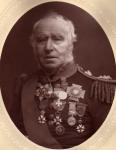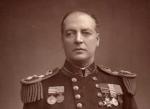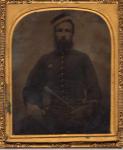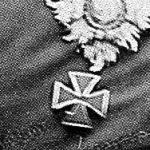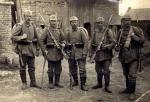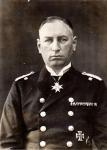-
Posts
2,143 -
Joined
-
Last visited
-
Days Won
10
Content Type
Profiles
Forums
Blogs
Gallery
Events
Store
Everything posted by Odulf
-
I have my doubts about this ribbon bar to be British, as the French also qualified for the same medals, also I find the sewing/stitching rather crude and the early contemporary ribbon bars that I had in my collection were neatly sewn and without the spacing I notice here. No soldier would gain respect with a sloppy ribbon bar as shon, not to mention the next you put up on show. To my understanding, the wear of ribbon bars started on the Continent in between 1830 and 1850, by ex-soldiers, as a souvenir-like display. From this era date many combined ribbons from Russia, German States, The Netherlands etc. Sometimes these were framed in gilted metal, silver or even gold, and with the miniature decorations/medals attached below. Also, the miniatures were worn on a (watch) chain (in Germany) by ex-service men. This custom was adapted by military folk in a time when dress regulations were not so strict. To understand this matter, one has to consider that (in GB) medals were regarded both as a souvenir but also as an internsic (silver) token or reward which could be turned into cash in times of need. As British medals were issued without a paper scroll (only the name in the rim and a name on a list in a far distant file) the medal on its own was the proof of evidence. On the Continent most medals were produced from (occupied) gun metal or alloy but the named document was the source. In England, long time serving soldiers/naval personnel wore their medals daily, but in performing duty this was not very practical, as dangling medals were lost or cought up in works, so only the ribbon was worn (seperated from the medal). Medals on the chest of serving military personnel were scarce before about 1860, and also recipients did not feel the need to show off as the circulation of personnel was low. The unit's members knew their respective past. When the number of medals increased, due to Empire military actions, more medals/ribbons were worn and thus the need for the Regulators of the Forces increased to catch this fashion in uniform regulations. To my understanding, the narrow (half inch) ribbons first came into use during or after the Boer War (c. 1900), but I may be wrong, my opinion is based on photographical evidence. When I put this fashion in a wider (European) perspective I notice that in the German States a clever system had come in use, by using a metal frame covered with ribbon and a hook, to which the badge (Order or Medal) could be attached. Other continental countries applied their own solutions. This fashion would call for a wider study, because it is, generally speaking, a white spot. I am investigating the customs about ribbon bars and the wear of miniature medals on uniform in The Netherlands, and I have learned that this custom was fed by German and French military habits; in the end it was sanctioned by military regulations, but that was long after the fashionable introduction. I thank you for launching this topic, and I hope for much response so that I may learn.
-
Until about 1863 photos show that decorations and medals were spread over the left chest, in no particular order of wear. From about that time the custom rises to wear decorations and medals in one line. As it is, the Dress Regulations follow (and regulate) custom. The Naval Dress Regulations 1879 specify the wearing of decorations and medals and I have not yet found any earlier regulation about this matter. For the sake of the example I enclose a portrait of Admiral Sir Sidney Colpoys Dacres from about 1871, wearing his decorations and medals all over his chest, and a portrait of Lord Charles Beresford from about 1886, wearing his decorations in accordance with the 1879 Regulations. Ribbons only were worn instead of the full size medal-and-ribbon, for the sake of ease and to prevent the loss/damage of medals and clasps. I have not yet seen any early photos of military personnel wearing more than one ribbon.
-
A copy from the paragraph about the wearing of decorations and medals, "Uniform Regulations for Officers, Petty Officers and Seamen of the Fleet" (1879). Note 125.c (decorations and medals are to be worn in a single horizontal line) and 125.5 (When ribbons only are worn, they must be half an inch in length.
-
An Ambro-Type photo (negative on glass) from about 1860, showing a trooper of the 17th Lancers wearing the ribbon of the Mutiny Medal. On this and other early photographic portraits, it can be seen that the hight of the earliest ribbons/ribbonbars worn on uniforms is nearly double compared to the later ribbons.
-

Uncategorised King Edward VII with the Iron Cross?
Odulf replied to Odulf's topic in Germany: All Eras: The Iron Cross
Aha, thank you very much Michael! But hat raises another question: though Royalty, are there any regulations about wearing non-State decorations on a military uniform and was he bending the rules, or is this a "once in a life time" picture of HRH wearing such a decoration? -

MG 08/15
Odulf replied to MG1918's topic in Germany: Imperial: Uniforms, Headwear, Insignia & Personal Equipment
Yep, they are non in underwear, but these are all arranged pictures; not in combat. It is nice that shoulderboards are shown, indicating that all Infantry Regiments had MG-Units. I am more interested in the orgnisational structures, and not in the mechanical differences of the MG in practice. -

SS Wall Plaque Wooden SS
Odulf replied to itaca's topic in Germany: Third Reich: Research, Documentation & Photographs
I quite agree with Chris, thanks for showing. -

MG 08/15
Odulf replied to MG1918's topic in Germany: Imperial: Uniforms, Headwear, Insignia & Personal Equipment
-

MG 08/15
Odulf replied to MG1918's topic in Germany: Imperial: Uniforms, Headwear, Insignia & Personal Equipment
-
Thank you for your comment, I keep a representative collection of French campaign medals, with a preference for the Médaille Coloniale and it's successor, the Médaille d'Outre Mer, and bars, because it represents France as a very busy international force for a long time. The "trouble" with French medals is that there is no "Government Issue" (so to say) and many contemporary and modern producers can/could make bars to the medal without hesitation. When you are not bothered by the fetish of "originality" you can build a fine selection of both medals and bars; when you dive into the nitty-gritties of authenticity you could end up with a headache and a lot of hassle. So I take a bar for what it is, some of my bars are contemporary and some date from a later period. To me it is only a trigger to dig deeper into the rich details of French colonial actions. It gets confusing when you find bars to these medals on other medals, which often happens, for (un) obvious reasons. This all has to do with the French regulations about medals and the not maintained principles of copyrights and the sometimes very personal ideas of ex-servicemen about extpressing the details of their career and service in their medals.
-

SS Wall Plaque Wooden SS
Odulf replied to itaca's topic in Germany: Third Reich: Research, Documentation & Photographs
Why would any German (in his right mind) use the word "BEERHAUS"?



